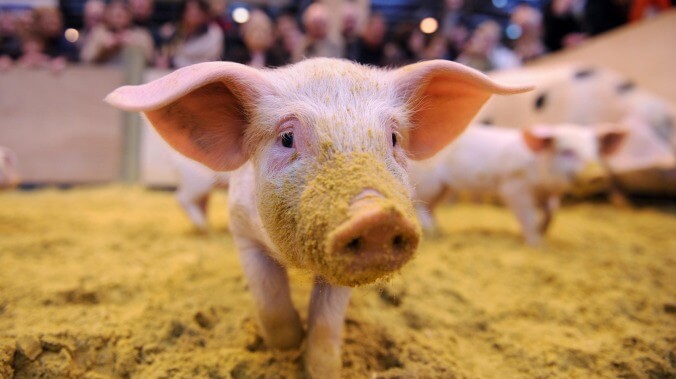As for the small islands between Vancouver and the mainland, the treaty stipulates that the border go “thence southerly through the middle of the said channel… to the Pacific Ocean.” Only problem: There are two middle channels—Haro Strait, and Rosario Strait, which run on either side of the San Juan Islands (Lopez, Orcas, and San Juan).
Strangest fact: The Pig War was nearly a front in the looming Civil War. Union General George McClellan later claimed that his friend and West Point classmate-turned Confederate General George Pickett (of Pickett’s Charge) had stoked tensions around the San Juan Islands to incite war with Britain, in order to unite North and South against a common enemy. As usual, the Confederates were given too much credit by history, as another Union officer, Colonel Granville Haller, suggested the likelier theory that Pickett wanted war so that the South could declare independence while America’s army was tied up fighting the British in Canada.
Thing we were happiest to learn: The pig was the only casualty of the Pig War. The whole thing started when Lyman Cutlar, an American farmer living on San Juan Island, which he believed to be U.S. territory, found a pig in his garden, eating his potatoes. The offending pig belonged to an Irish sheep rancher, Charles Griffin. After several warnings, and the pig pilfering potatoes on several occasions, Cutlar lost his temper and shot the animal. He offered $10 in recompense ($290 in today’s money), but Griffin demanded ten times that amount. When Cutlar refused, saying the whole thing was Griffin’s fault for letting his pig roam free, Griffin called the local (British) authorities and threatened to have Cutlar arrested. Cutlar rallied his American neighbors on the island and called for U.S. military protection.
Thing we were unhappiest to learn: The neighborly dispute quickly escalated to the brink of war. The U.S. dispatched Pickett (then a Captain) and the 9th Infantry to San Juan, hoping to stop the British from landing. The Brits sent three warships, and Pickett boasted, “We’ll make a Bunker Hill of it,” building a fortification on high ground at the south end of the island. Each side sent reinforcements. By August 10, 1859, two months after the pig incident, Pickett had 461 men and 14 cannons, facing down five British warships with 70 guns and 2,140 men on board between them. The governor of Vancouver Island ordered Rear Admiral Robert Baynes to land on San Juan and engage the Americans. Baynes refused, not wanting to involve “two great nations in a war over a squabble about a pig.”
Instead, both sides hurled insults, but no shots were fired as neither side wanted to make the first move. President James Buchanan sent General Winfield Scott to parlay with the governor, and both sides settled on a peaceful joint military occupation, with the Americans retaining their position on the south end of the island, and the British setting up camp on the north. This went on until 1871, when the two sides called in German Emperor Wilhelm I to arbitrate. He found in favor of the U.S. The British withdrew, but the Union Jack is still flown over their camp in commemoration—one of the only non-embassies where the U.S. government raises a foreign flag.
Best link to elsewhere on Wikipedia: Griffin, the pig’s owner, was sent to work on San Juan by the Hudson’s Bay Company. The company was founded in 1670 by King Charles II to try and break the French monopoly on the Canadian fur trade, but their territory encompassed Eastern Canada. In 1779, rival traders formed the North West Company, whose territory stretched to the Pacific. The two had such a bitter, often violent rivalry, that the Crown forced a merger in 1821 to keep the peace. The HBC quickly became a monopoly, operating as far away as Hawai’i.
Remarkably, the HBC still operates today. In the late 1800s, they started expanding the company’s trading posts until they grew into the precursor for the modern department store. They eventually bought competitors Zellers, Kmart Canada, and Saks, and were themselves bought by the equity firm that owns Lord & Taylor. The CEO of HBC still retains the traditional title of “Governor,” first held by Prince Rupert in 1670. (His successor, James Stuart, stepped down after two years to become King James II.)
Further Down the Wormhole: The American fortification on the southern end of San Juan Island was designed by a recent West Point grad named Henry Martyn Robert. He subsequently worked for the Army Corps Of Engineers, building defenses for Washington, D.C., and Philadelphia during the Civil War, improving harbors from Green Bay to New York afterwards. But his most lasting contribution is his book, Pocket Manual Of Rules Of Order for Deliberative Assemblies, better known by its pithier title, Robert’s Rules of Order, which has been the weapon of sticklers at school board and homeowners’ association meetings across the land ever since.
While the Army Corps Of Engineers are best known for building civilian infrastructure like the Panama Canal, Bonneville Dam, and Comprehensive Everglades Restoration Plan, they also built the facilities that housed the Manhattan Project. One of the most ambitious scientific efforts in history, the Manhattan Project discovered how to split the atom and harness the resulting energy for a devastating weapon. But it wasn’t the only secret weapons project in the New Mexico during WWII. We’ll look at the military’s far less ambitious project to develop a bat bomb next week.













![HBO teases new Euphoria, Larry David, and much more in 2026 sizzle reel [Updated]](https://img.pastemagazine.com/wp-content/avuploads/2025/12/12100344/MixCollage-12-Dec-2025-09-56-AM-9137.jpg)



























